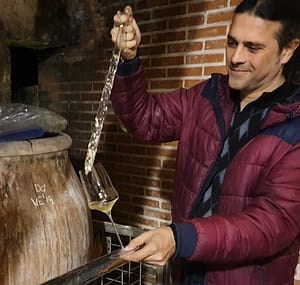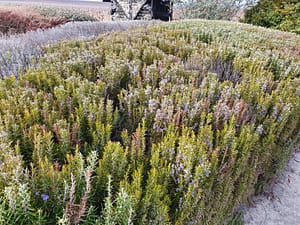We end our journey with some more recent initiatives. Their history is not necessarily that short though. Menade for instance is relatively new, and the launch of their oxidative wine too. But the companiy’s history can be traced many generations back, and their dorado has also some history.
Menade was officially founded in 2005. But this branch of the Sanz family can trace its wine history back to 1820, when they sold their first vintage to the mayor of La Seca. At that time, there was more red wine than white. Antonio Sanz was one of the pioneers of Rueda and of Spanish wine in general; he traveled around, among other places to the Basque Country to see how they made wine there. He took part in the revolution to avoid oxidation; pick at night and use steel tanks – and to start DO Rueda. Now his three children in the 6th generation are leading the family business. Menade operates completely organically and is committed to spontaneous fermentation. The family sold the famous brand Palacio de Bornos, and the bodega which later got the same name. But they kept the vineyards. Menade benefits from the use of these today.
Here we meet again my musician friend, who I first met in another Rueda bodega. Ivan Acebes García is generally interested in culture and speaks long and inspired. His thoughts on the history of the Spanish nation will not be discussed in detail here. But he says that for 250 years, solera was the way to make wine here. It was to make the process cheaper that they started placing the wine out in the sun. It is natural that Ivan asks if we can meet in the old bodega in La Seca, where a living room is filled with books. Later we drive to what has been the headquarters since 2009 in Rueda town. There they have made an organic bodega, laid out a garden with all the typical plants – and supplemented with, among other things, an “insect hotel”. Menade has a total of 210 hectares, 60 here at the farm in Rueda. Their homage to the dorado tradition they call Adorado. The vines for this are between 20 and 25 years old, and the grapes are picked by hand.
-Every year we harvest earlier, says Ivan, with the global warming in mind.
We are out in Menade’s biodiversity paradise. There is a lot of fennel: -All verdejo smells like fennel, other typical smells are rosemary and thyme, he points out.
It’s getting late, and a breeze has crept in over the inhospitable Castilian landscape.
-Here, far inland there is actually a certain Atlantic influence, he says, -there is nothing to stop the wind between the sea and these fields.
The pressing takes place in a historical vertical press from around the year 1900, when it is believed that an earlier incarnation of this particular wine was made for the first time. The must is cloudy, and the fermentation starts naturally. After fermentation, the finished wine is fortified with grape spirits to obtain 2 or 3 extra grades of alcohol. Flor develops, usually in the spring, and when it has disappeared, the oxidative process resumes in the old underground bodega in La Seca. -The mother solera of Adorado dates back to 1967, but the first “saca” (withdrawal from the solera) was as late as 2018, when we made the decision to reactivate this style, Ivan continues. Unlike the other well-known producers, Menade uses 8-liter damajuana. The wine is released on the market without clarification or filtration.
This dorado has even more saline expressiveness than the aforementioned wines. In addition it has evident iodine and umami features. It has a clear amber color with a golden element.
Vidal Soblechero
I always appreciate coming back to Alicia and Vidal Vidal Soblechero in La Seca. (No, there is no misprint there.) Vidal is a passionate “bird man” and is the only one who has made me hold a bird of prey on my arm. By the way, his falcons have a function; they keep pests away from the vines. Alicia is a music lover and this time she invited me to a baroque organ concert in the local church of La Seca.
Actually, I find it strange that this producer is not more famous. They did get a lot of attention when they made Spain’s first ice wine in 2010, but it was probably quickly sorted under curiosities. No, it is their single-parcel wines that most of all arouse interest and admiration. I always make sure to taste some, if not all, of these. The wine series Pagos de Villavendimia was born precisely with the aim of expressing the characteristics of the various plots.
The Vidal Soblechero family has 50 hectares on 32 plots. Nothing is bought-in, no vineyard is rented. It was his father Cláudio who was behind the standard verdejo Clavidor (also derived from his name).
La Oxidativa, their dorado, comes under this label Pagos de Villavendimia. It is made from 100% verdejo from over 80 years old vines and stored in damajuanas that are always full, in a form of solera from 1947.
-It started, once told their distributor Joachim Buchta, -when Cláudio Vidal put a barrel in the yard filled with ordinary verdejo. Then he placed enough damajuanas around it on the ground. After six months, he replenished ten percent of the wine from the barrel with the wine from the damajuanas. Then he refilled the damajuans. Over the years, the number increased. Now it’s around ten.
This explanation is perhaps good for understanding how the solera system works in this context. The point here is that there are barrels that never run out, that there is a small amount left from the first vintage.
Another point is that at Vidal Soblechero, dorado is fermented like ordinary verdejo, with potentially about thirteen percent alcohol. You are then sure to end up with a completely dry wine.
We see that this is a type of wine that several producers are now bringing to light again, and beyond the four I had planned to visit especially with a view to dorado, I will mention two. I had agreed to visit Ismael Gozalo anyway, and he gave me a bottle of his historical wine when I was about to leave. And to a trade fair in Barcelona, Malaparte had also brought their oxidative wine.
Ismael Gozalo
Ismael Gozalo’s father was one of the founders of Viñedos de Nieva, a reference in the area. And he himself was behind Ossian together with Javier Zacchagnini, known from Ribera del Duero. In 1998, Ismael started making wines outside the family’s bodega, and it did not take long before everything was produced organically, as natural wine without additives. Nieva, the small village where he was born in 1971, is one of the highest in Rueda, 850 meters above sea level. With less than 300 inhabitants, Nieva has four significant wineries, which must be said to be an unparalleled density.
Ismael Gozalo has 31 hectares, only “en vaso”, without upbinding, which is very common in Spain, with all its old vineyards. The wine EvoluciÓn comes from one of Gozalo’s best vineyards, 180-year-old pre-phylloxera in sandy soil. The wine is based on the vintages 2010 and 2011. It has then been over ten years in old sherry barrels. It has a permanent flor layer based on yeast cells from the bodega since the 11th century. As he writes on the baking label, it is “stored under flor (flower), bottled on a ‘día de flor’ (flower day) and you can enjoy this flor (wine flower)”. He may be called the “verdejo alchemist”, for his creative ways of dealing with this emblematic grape. Obviously, he also uses 100% verdejo for his dorado. Ripe grapes are picked by hand, spontaneously fermented and stored in barrels, which are only filled up with 5/6 of the capacity. The wine achieves an alcohol of 15%, but evaporates, and when the wine has 13.5%, it is not refilled with alcohol, but bottled as it is. It would thus not have been approved by DO Rueda. 950 half litre bottles were produced.
EvoluciÓn is stored longer under flor than the aforementioned wines. Therefore, one might call it pálido rather than dorado. Surely it is that it is also made after inspiration from the historical wines from Rueda. Because of a longer time under flor it is lighter than the others in colour. It is aromatic, with hints of ripe apples and plum and a yeasty flor characteristic. It is a very fresh wine with good concentration, vital acidity and a sweetish fruit sensation. Dry in the mouth, and good length.
Like Gozalo, Bodega de Frutos Marín is located in the province of Segovia. The producer is most often called Malaparte, after its most famous label. Rubén and Elisa cultivate 5.5 hectares of vineyards near Cuéllar. They use different techniques, such as tanks, old barrels and amphorae. All plots are operated without irrigation. This is near the Ribera del Duero. Still, and despite a lovely amphora-aged tempranillo, I would say that they are mostly a white wine producer, offering several versions of verdejo and viura. Interesting for us in this round is the wine OX. This is obviously an abbreviation of “oxidativo”. It is based on verdejo and palomino fino from 65 year old vines. After a year it was transferred to damajuanas. It naturally reaches 14%, and is not strengthened. It has all the yeast, almond and dried fruit aromas one would expect, and in the mouth it is glyceric – and typically more fruity than its sherry equivalents.
Maybe the dorado drink can get a place at our tables again? The first mentioned wines (see part I and II) should have similar use as a young or medium aged amontillado or palo cortado sherry. If we should refer to what the producers themselves are suggesting, it can be anything from cured cheeses, via stews, anchovies, bacalao, foie and smoked and pickled starters – to salty and sweet foods, such as blue cheese and chocolate-based desserts. EvoluciÓn will probably be more like a fino, manzanilla pasada or young amontillado, with some lighter food. One of Gozalo’s importers mentions Asian-inspired dishes and red fish. It would probably suit some of the others as well.
The golden age was called the era after the discovery of America. It remains to be seen whether the golden drink is now facing a new golden age.











